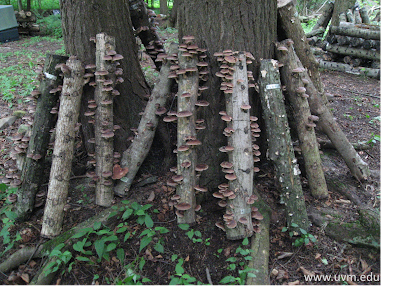Krewe de Shiitake: post-Mardi Gras Inoculation Workshop
Shiitake mushrooms are the fruiting bodies of the fungus Lentinula edodes (syn=Lentinus edodes). The word “shiitake”
coined in 1877 by the Japanese is derived from Shii referring to “wood” and Take
referring to “mushroom”, so all-in-all it translates to “wood mushroom”. Shiitake mushrooms have been around since
prehistoric times, and have used as medicine in Asia for thousands
of years. In light of research on the medicinal benefits of Shiitake mushrooms,
the United States have accepted this fungal critter into our
diets in the last two decades. Growing mushrooms is a commitment and must be taken seriously for the backyard fungiphile or the commercial mushroom producer. Currently, there are approximately 200 commercial Shiitake producers in the United States who produce their
products on hardwood trees such as oak and sweet gum.
Growing Shiitake mushrooms in your backyard is a very
labor-intensive project, and should be well planned before jumping the gun.
When thinking about growing Shiitake mushrooms major things should be
thought about, all of which relate to the biology of the fungus; they are: 1) the Shiitake
strain, 2) the environment, and 3) the substrate on which the fungus is grown. These three factors are part of a matrix that’s
product is a bountiful harvest of beautiful Shiitake mushrooms.
The shiitake strain chosen should be a strain that can withstand temperature and moisture ranges that are normal for your area. For example, in
the Southeast we would want to grow a warm strain that likes humidity.
REMEMBER: these fungi are LIVING! How would you like it if you were thrown into
a fire or an ice bath? Make your fungus happy, and it will make you happy!
The second parameter of our mushroom matrix is “the
environment”. The environment is key for several reasons; 1) temperature and
moisture are major players in fungal growth and fruiting potential of shiitake
mushrooms, 2) if the environment is not right than the shiitake fungus can’t
establish itself and “trash” fungi move in, and your operation is ruined, and 3)
sunlight indirectly affects fungal growth by removing moisture from the forest
floor or substrate logs.
The substrate is the last parameter in our mushroom
cultivation matrix. The substrate refers to the substance or material in which
an organism feeds; so in the case of shiitake it’s wood! What type of wood is
best? The rule of thumb is: Oaks are the best substrate for shiitakes!
Preferably laurel oak, water oak or live oak, but sweet gum and other hardwoods
have been known to work well too!
So, if we were going to grow shiitake mushrooms in New Orleans Louisiana we
would want a warm strain shiitake, grown on freshly cut oak that has high
moisture content (maybe soaked), and incubated and grown in a shaded
environment.
Like plants, if the fungus isn’t “happily” growing then you
are probably opening up many doors of problems including contamination, animal grazing,
or possibly death to your fungus. Planning your mushroom operation or conducting a trial for
your local area, first, really could help your business idea thrive.
More reading:




No comments:
Post a Comment